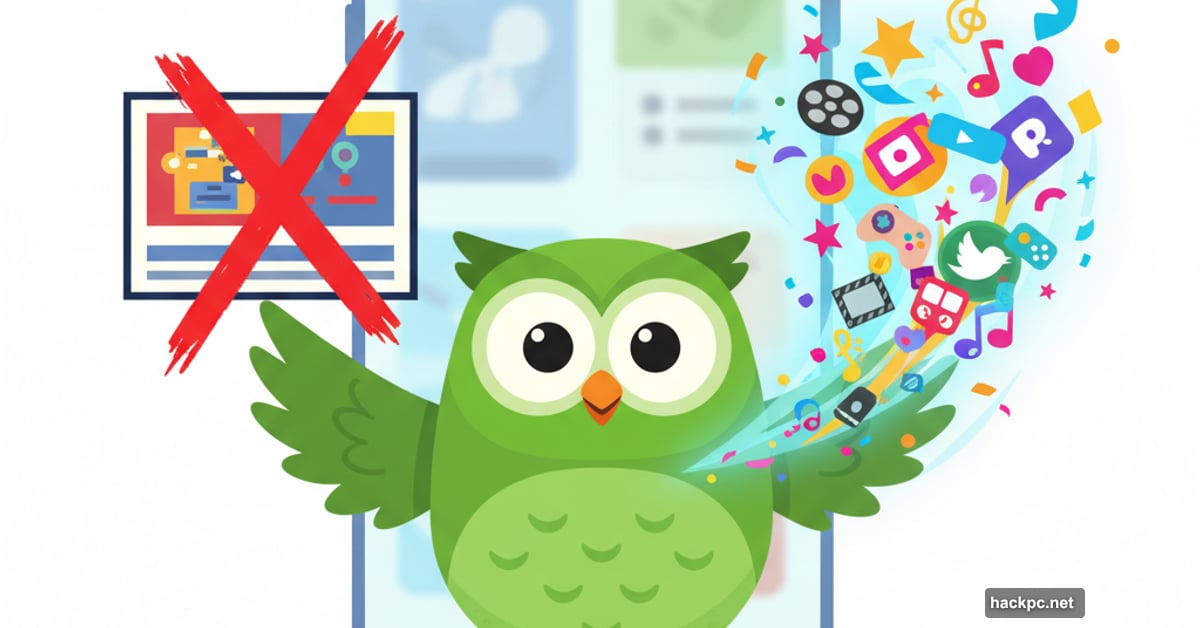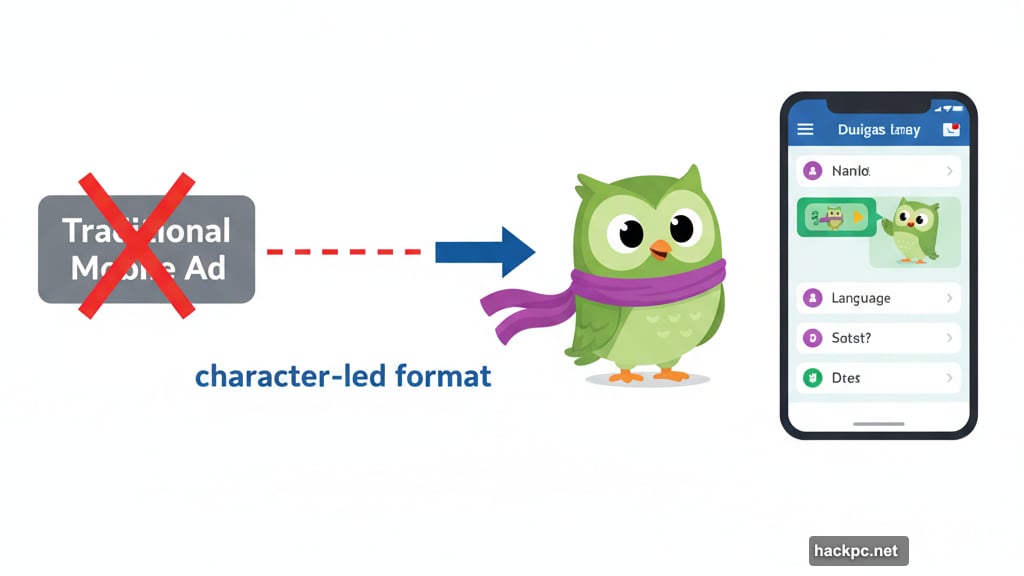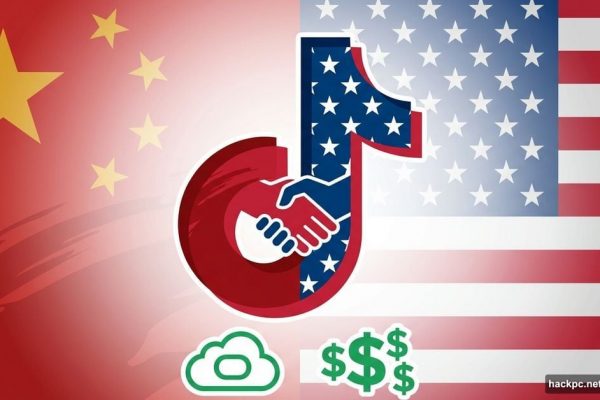
Duolingo wants to keep language learning free. But not by annoying you with ads.
The company just launched Duolingo Ads, a new mobile advertising platform that turns sponsored content into entertainment. Instead of interrupting lessons with generic banner ads, brands now star alongside Duo the Owl and his quirky friends.
It’s a bold move. And early results suggest it’s working better than anyone expected.
Why Duolingo Built Its Own Ad Network
Free education costs money to maintain. Duolingo serves 128 million daily users who never pay a cent. That infrastructure doesn’t run itself.
Traditional mobile ads could solve this problem. But they’d also ruin the experience that made Duolingo popular in the first place. So the company tried something different.
“Ads don’t have to be annoying,” says Andrew Guendjoian, head of ad sales at Duolingo. “They can actually be delightful.”
The platform builds on character-led formats Duolingo already uses to promote its own subscription tiers. Those ads performed significantly better than standard placements. Plus, users actually liked them in focus groups.
So Duolingo adapted the same approach for brand partnerships. The result feels less like advertising and more like bonus content featuring familiar characters.
How the Platform Actually Works
Duolingo Ads offers two main character formats. First, fully animated spots featuring Duo or other beloved characters from the app. Second, animated character introductions that lead into partner video content.
Both formats integrate seamlessly into the lesson flow. Plus, they maintain Duolingo’s distinctive humor and personality.
The platform also includes two full-screen mobile formats. Interstitial ads appear after lesson completion and become skippable after five seconds. Rewarded videos are opt-in experiences that give users in-app currency.
This entertainment-first approach rejects the traditional interruption model. Instead, ads blend into experiences users already enjoy. The line between content and advertising gets deliberately blurry.
Launch Partners Share Common Ground
Adobe, Intrepid Travel, and Universal Pictures joined as launch partners. That’s not random selection.
These brands align naturally with why people use Duolingo in the first place. Creativity, exploration, and storytelling connect directly to language learning motivations. So their presence feels culturally appropriate rather than forced.
Duolingo’s internal writers and designers collaborate directly with partners on creative development. Each project includes dedicated character and brand stewards. They ensure ads feel authentic to both the sponsor’s story and Duolingo’s distinctive voice.
The company recommends which characters to feature based on personality fit. Characters appear the same way they do in regular lessons. That consistency maintains authenticity and keeps the experience cohesive.
The Numbers Tell an Interesting Story
Early testing revealed some surprising performance metrics. Video completion rates hit 96%. That’s remarkably high for mobile advertising.
Click-through rates reached up to 30% in initial tests. That significantly exceeds typical industry benchmarks, where 2-5% counts as strong performance.
These numbers suggest users actually engage with the content rather than immediately skipping it. The entertainment value appears to overcome typical ad avoidance behavior.
Moreover, user surveys and focus groups returned positive feedback. People don’t seem to mind these ads. Some actually enjoy them. That’s rare in mobile advertising.
Gen Z Attention Comes Built-In
Duolingo cracked a tough problem: reaching gen z at scale. This demographic notoriously ignores traditional advertising and uses ad blockers aggressively.
But Duolingo became part of daily routines for millions of young users. They open the app every day, They engage deeply with content, they share memes about Duo’s aggressive reminder notifications.
That engaged user base creates valuable advertising inventory. Brands pay premium rates to reach audiences this attentive and difficult to access elsewhere.
However, Duolingo maintains careful control over the experience. The platform doesn’t simply sell impressions to the highest bidder. Partners must align culturally with the brand and user expectations.

What This Means for Mobile Advertising
Duolingo’s approach challenges standard mobile ad practices. Most apps treat advertising as a necessary evil. They maximize revenue while minimizing user complaints.
Duolingo invests creative resources into making ads genuinely entertaining. That requires more effort upfront. But it generates better performance and protects the core product experience.
This model only works because Duolingo built strong brand equity first. Users love the characters. They appreciate the humor. They trust the company’s approach.
Other apps can’t simply copy this strategy without that foundation. You need beloved characters and a distinctive voice before character-led advertising makes sense.
Still, the core insight applies broadly. Entertainment-first advertising generates better results than interruption-based formats. Users reward brands that respect their attention and time.
The Bigger Bet on Free Education
Duolingo Ads exists to keep language learning accessible. The company could force more users toward paid subscriptions. They could sell traditional ad inventory at higher volumes. They could implement paywalls for advanced features.
Instead, they’re betting that better advertising maintains free access while generating sustainable revenue. That’s genuinely unusual in an industry obsessed with converting free users to paid subscribers.
Andrew hints that new native formats are coming soon. The company plans to “surprise and delight learners while helping brands earn authentic attention.”
That suggests Duolingo sees this as a long-term platform, not a short-term revenue experiment. They’re investing in advertising that feels like content rather than interruption.
Whether other education apps follow this approach depends on early results. But Duolingo’s 96% completion rates and 30% click-through rates make a compelling case for entertainment-first advertising.
The challenge lies in execution. Most brands lack Duolingo’s creative resources, beloved characters, and deeply engaged user base. Copying the tactics without those advantages probably won’t work.
But the underlying principle holds value. Respect user attention. Integrate advertising naturally. Make ads entertaining enough that people actually want to watch them.
Duolingo just proved that model generates better results than treating ads as an unfortunate necessity. Now we’ll see if other companies can execute it successfully.



Comments (0)